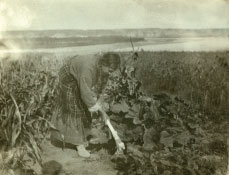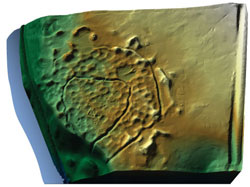We’ve launched a new web portal! Visit findhistory.nd.gov to search our collections.
Due to a road closure, the Killdeer Mountain Battlefield State Historic Site is temporarily closed.
The Mandans built dome-shaped houses of logs and earth, known as earth-lodges. All that remains of the earthlodges on the surface are circular depressions. The men usually decided how large an earthlodge would be, and the women did most of the building. To build an earthlodge, a wooden framework was erected, then covered with layers of willow branches, grass, and finally, earth. It took about 150 trees to build one earthlodge. Earthlodges typically were 35 to 45 feet in diameter, although they varied from 20 to 65 feet, and housed a family of eight to twenty people.
 The Mandans are one of the best-known agricultural tribes of the Missouri Valley region. The Missouri River valley provided water, food, and shelter for the Mandans. Abundant timber and game could be found in the wooded bottomlands, and bison flourished on the surrounding prairie grasslands. The terrace-edge settings of the villages offered access to garden land and abundant timber as well as extensive views up and down the valley. The Mandans developed a rich and elaborate culture based on farming and bison hunting. Farming produced a large surplus of food which could be stored for use during leaner times and traded to nomadic, non-farming groups. Principal crops include corn, beans, and squash. Sunflowers and tobacco also were grown.
The Mandans are one of the best-known agricultural tribes of the Missouri Valley region. The Missouri River valley provided water, food, and shelter for the Mandans. Abundant timber and game could be found in the wooded bottomlands, and bison flourished on the surrounding prairie grasslands. The terrace-edge settings of the villages offered access to garden land and abundant timber as well as extensive views up and down the valley. The Mandans developed a rich and elaborate culture based on farming and bison hunting. Farming produced a large surplus of food which could be stored for use during leaner times and traded to nomadic, non-farming groups. Principal crops include corn, beans, and squash. Sunflowers and tobacco also were grown.
In the archaeological record the dominant role of bison, hunted for their hides and meat, is evident. Other animals also were hunted and trapped, including pronghorns, deer, wolves, rabbits, beavers, muskrats, porcupines, foxes, mink, badgers, and bobcats. A diverse variety of birds (waterfowl, hawks and eagles, grouse, cranes, owls, woodpeckers, crows, ravens, and small songbirds) and fishes (sturgeons, gars, mooneyes, pikes, suckers, catfishes, and cods) are represented in the archaeological record. These animals all contributed to the subsistence of the villagers. Each supplied an important source of bone for tools and ornaments, as well as being tapped for their hides, furs, and plumage.
Fortification systems consisted of a deep moat and a wall of wooden posts that formed a palisade. Natural features, such as steep terrain and riverbanks, also were used for added protection. Fortification systems attest to the fierce warfare between villagers and surrounding nomadic tribes that is reported in early historic records.
 The raised areas around the village are midden mounds or earthen mounds ranging from one to ten feet high. There are more than 30 mounds surrounding the village. The oldest mounds, dating to AD 1550-1650, occur directly atop Ditches 3 and 4. Excavations showed some mounds to be accumulations of household refuse - animal bones, broken pottery, and ash from hearths - carried and dumped in huge heaps. Other mounds were composed partially or entirely of fill excavated from elsewhere in the village, clearly indicating that those mounds were intentionally constructed. During one phase of occupation, the village defense involved a combination of Ditch 2, which lacked bastions, and several large mounds placed as strong points just inside the ditch.
The raised areas around the village are midden mounds or earthen mounds ranging from one to ten feet high. There are more than 30 mounds surrounding the village. The oldest mounds, dating to AD 1550-1650, occur directly atop Ditches 3 and 4. Excavations showed some mounds to be accumulations of household refuse - animal bones, broken pottery, and ash from hearths - carried and dumped in huge heaps. Other mounds were composed partially or entirely of fill excavated from elsewhere in the village, clearly indicating that those mounds were intentionally constructed. During one phase of occupation, the village defense involved a combination of Ditch 2, which lacked bastions, and several large mounds placed as strong points just inside the ditch.
![]() Follow Double Ditch Indian Village State Historic Site on Facebook!
Follow Double Ditch Indian Village State Historic Site on Facebook!
Address:
ND 1804, Bismarck
Located seven and one-half miles north of Bismarck.
Get Directions
Hours:
Site open year round.
Contact Us:
phone: 701.328.2666
email: history@nd.gov